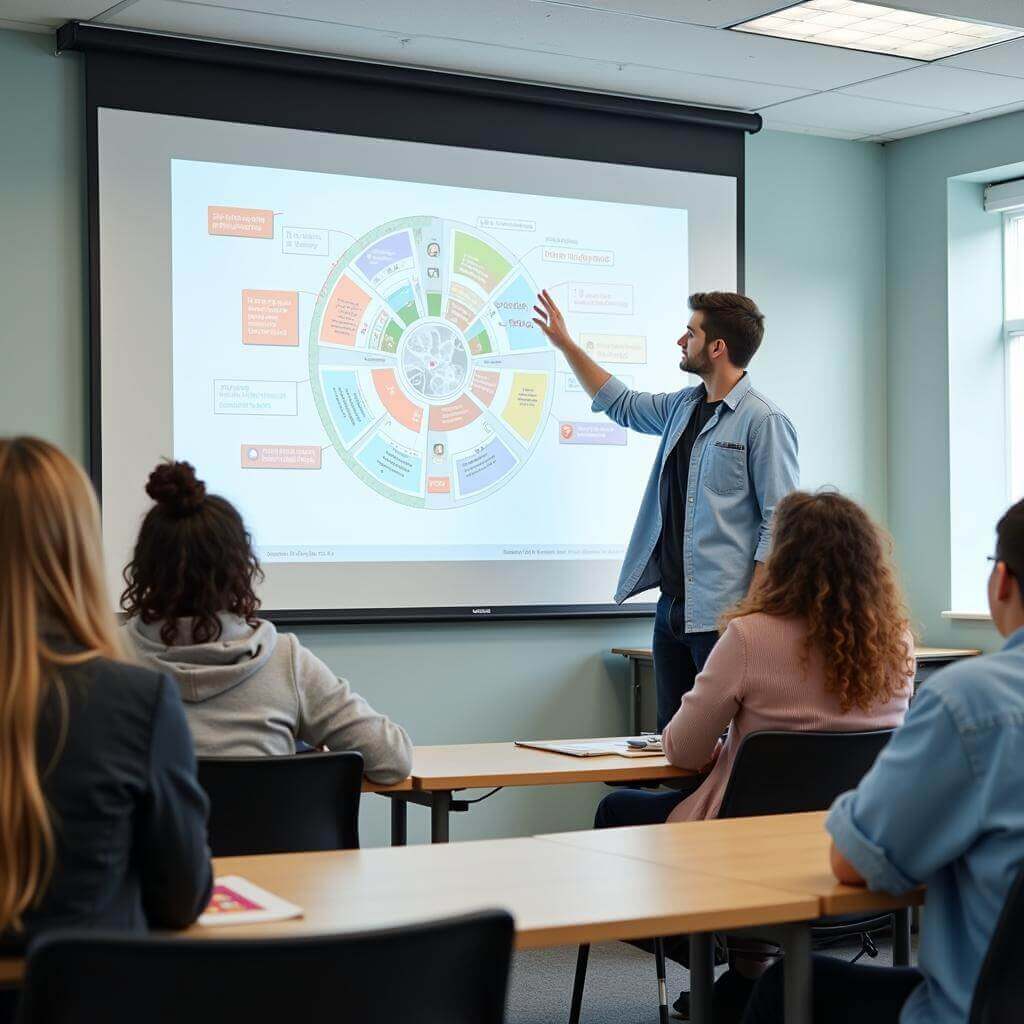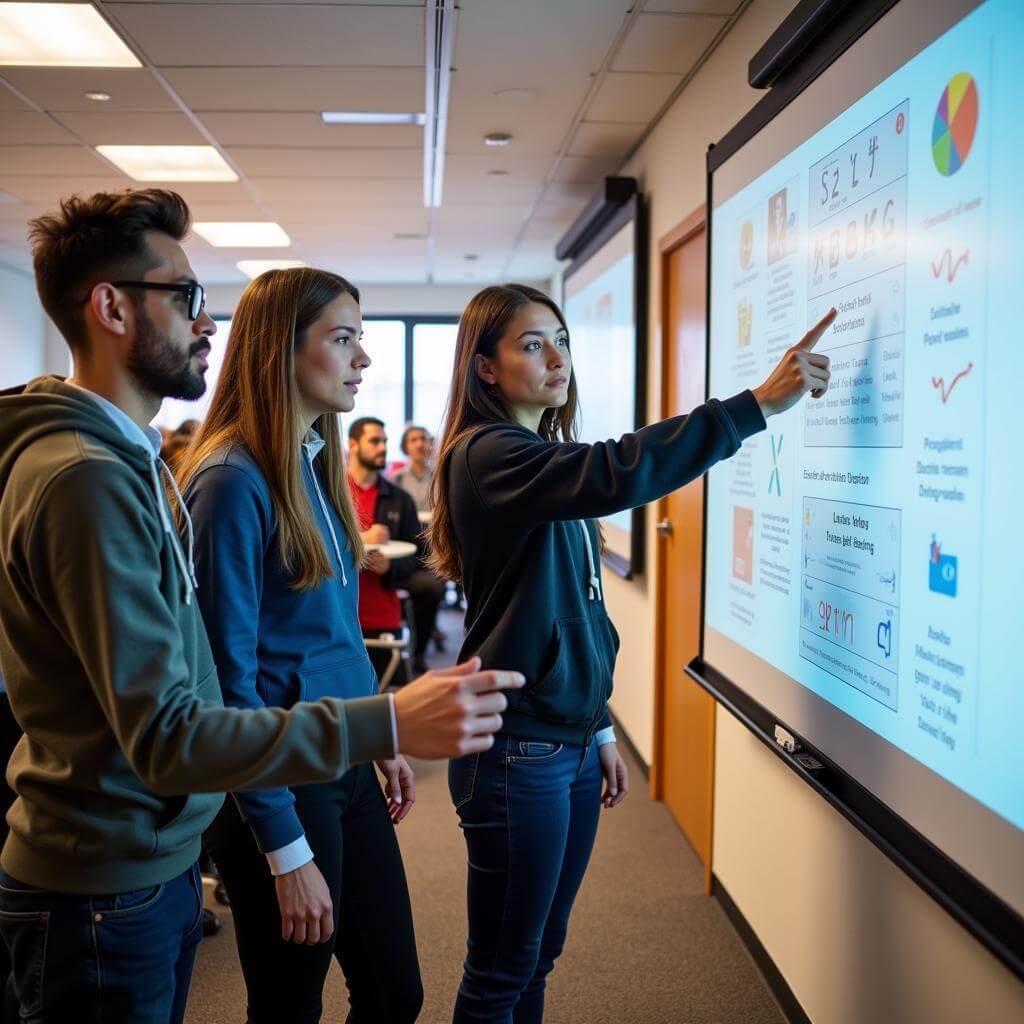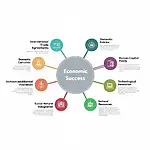The IELTS Reading test often includes passages on educational topics, such as the use of technology in classrooms. Today, we’ll explore a sample IELTS Reading test focusing on how interactive whiteboards are enhancing classroom engagement. This practice test will help you improve your reading skills and familiarize yourself with the types of questions you may encounter in the actual IELTS exam.
Technology for interactive classroom activities has become increasingly important in modern education. Let’s dive into our IELTS Reading practice test to explore this topic further.
Passage 1 – Easy Text
The Rise of Interactive Whiteboards in Education
Interactive whiteboards have revolutionized the way teachers and students interact in classrooms around the world. These digital devices, which combine the functionality of a traditional whiteboard with the power of a computer, have become increasingly popular in educational settings over the past decade.
The primary advantage of interactive whiteboards is their ability to engage students in a more dynamic and participatory learning experience. By allowing teachers to incorporate multimedia elements such as videos, images, and interactive simulations into their lessons, these devices can cater to various learning styles and keep students more focused and interested in the subject matter.
Moreover, interactive whiteboards facilitate collaborative learning by enabling students to interact directly with the content displayed on the screen. This hands-on approach can help reinforce concepts and improve retention of information. Teachers can also save and share lessons, making it easier to review material or provide resources for students who missed a class.
The impact of digital learning environments on student engagement has been significant, with interactive whiteboards playing a crucial role in this transformation. Studies have shown that classrooms equipped with these devices often see improvements in student participation, motivation, and overall academic performance.
However, it’s important to note that the effectiveness of interactive whiteboards depends largely on how they are used. Teachers need proper training to maximize the potential of these tools and integrate them seamlessly into their teaching methods. When used effectively, interactive whiteboards can create a more inclusive and engaging learning environment that prepares students for the technology-driven world they will encounter beyond the classroom.
 Interactive whiteboard in a modern classroom
Interactive whiteboard in a modern classroom
Questions 1-5
Do the following statements agree with the information given in the passage? Write
TRUE if the statement agrees with the information
FALSE if the statement contradicts the information
NOT GIVEN if there is no information on this
- Interactive whiteboards have been widely used in classrooms for more than 20 years.
- Interactive whiteboards can accommodate different learning styles among students.
- Teachers can use interactive whiteboards to share lessons with absent students.
- All teachers find it easy to use interactive whiteboards without training.
- Interactive whiteboards are only effective in teaching science subjects.
Questions 6-10
Complete the sentences below with words from the passage. Use NO MORE THAN TWO WORDS for each answer.
- Interactive whiteboards combine the features of a traditional whiteboard and a ____.
- The ability to include ____ elements in lessons is a key advantage of interactive whiteboards.
- Interactive whiteboards enable a more ____ approach to learning, which can help students better understand concepts.
- Classrooms with interactive whiteboards often see improvements in student ____ and motivation.
- To use interactive whiteboards effectively, teachers require proper ____.
Passage 2 – Medium Text
The Impact of Interactive Whiteboards on Student Engagement and Learning Outcomes
The integration of interactive whiteboards (IWBs) into classrooms has been a subject of considerable interest among educators and researchers alike. These technological tools have the potential to transform traditional teaching methods and create more engaging learning environments. However, the actual impact of IWBs on student engagement and learning outcomes is a complex issue that warrants careful examination.
One of the most frequently cited benefits of IWBs is their ability to increase student engagement. The visual and interactive nature of these devices can capture and maintain students’ attention more effectively than traditional teaching tools. For instance, teachers can use IWBs to display dynamic content, such as animations and simulations, which can help students visualize complex concepts in subjects like science and mathematics. This enhanced visualization can lead to improved understanding and retention of information.
Moreover, IWBs facilitate active participation in the learning process. Students can interact directly with the content displayed on the board, manipulating objects, solving problems, and participating in interactive quizzes. This hands-on approach not only makes learning more enjoyable but also promotes deeper cognitive processing of the material.
The influence of interactive maps in geography lessons is a prime example of how IWBs can enhance subject-specific learning. Students can explore geographical concepts in a more immersive and interactive way, leading to better comprehension and retention of spatial information.
However, it’s important to note that the mere presence of IWBs in classrooms does not guarantee improved learning outcomes. The effectiveness of these tools largely depends on how they are integrated into the curriculum and utilized by teachers. Studies have shown that when IWBs are used primarily for teacher-centered activities, such as simple presentations, their impact on student learning may be limited.
To maximize the potential of IWBs, teachers need to adopt student-centered approaches that encourage active learning and collaboration. This might involve using the IWB for group activities, problem-solving exercises, or interactive discussions. Additionally, teachers should receive adequate training and support to effectively incorporate IWBs into their teaching practices.
Research on the impact of IWBs on academic achievement has yielded mixed results. While some studies report significant improvements in test scores and overall academic performance, others find little to no effect. These discrepancies may be attributed to various factors, including differences in implementation strategies, subject areas, and the duration of IWB use.
It’s also worth considering the potential drawbacks of IWB use. Some critics argue that overreliance on technology can lead to a decrease in traditional literacy skills or reduce opportunities for face-to-face interaction. Additionally, the high cost of IWBs and associated maintenance can be a significant barrier for schools with limited resources.
In conclusion, while interactive whiteboards have the potential to enhance student engagement and learning outcomes, their effectiveness depends on thoughtful implementation and appropriate pedagogical strategies. As with any educational technology, IWBs should be viewed as tools to support and enhance teaching and learning, rather than as a replacement for effective instruction.
 Students collaborating on an interactive whiteboard
Students collaborating on an interactive whiteboard
Questions 11-14
Choose the correct letter, A, B, C, or D.
-
According to the passage, one of the main advantages of interactive whiteboards is their ability to:
A) Replace traditional teaching methods entirely
B) Reduce the workload of teachers
C) Increase student engagement in lessons
D) Eliminate the need for textbooks -
The effectiveness of interactive whiteboards in improving learning outcomes:
A) Is guaranteed in all classroom settings
B) Depends largely on how they are used by teachers
C) Is only significant in science and mathematics
D) Has been consistently proven across all studies -
To maximize the potential of interactive whiteboards, teachers should:
A) Use them primarily for presentations
B) Limit student interaction with the boards
C) Adopt student-centered approaches
D) Focus on teacher-centered activities -
Research on the impact of interactive whiteboards on academic achievement has:
A) Consistently shown significant improvements
B) Produced mixed results
C) Proven them to be ineffective
D) Only been conducted in a few subject areas
Questions 15-20
Complete the summary below using words from the passage. Use NO MORE THAN TWO WORDS for each answer.
Interactive whiteboards (IWBs) have the potential to transform classrooms by creating more (15) ____ learning environments. They can help students visualize (16) ____ concepts, especially in subjects like science and mathematics. IWBs promote (17) ____ in the learning process, allowing students to interact directly with the content. However, the effectiveness of IWBs depends on their integration into the (18) ____ and how teachers use them. To be most effective, IWBs should be used for (19) ____ that encourage active learning and collaboration. Some potential drawbacks of IWB use include the possibility of decreased (20) ____ skills and the high cost of implementation.
Passage 3 – Hard Text
The Cognitive and Pedagogical Implications of Interactive Whiteboard Technology in Education
The proliferation of interactive whiteboard (IWB) technology in educational settings has sparked a vigorous debate among researchers, educators, and cognitive scientists regarding its impact on teaching methodologies and learning processes. While proponents laud the potential of IWBs to revolutionize classroom dynamics, critics caution against overreliance on technology at the expense of fundamental pedagogical principles. This discourse necessitates a nuanced examination of the cognitive and pedagogical implications of IWB integration in educational contexts.
From a cognitive perspective, IWBs offer unique affordances that align with contemporary theories of learning. The multimodal nature of IWB content presentation—combining visual, auditory, and kinesthetic elements—resonates with the principles of cognitive load theory and dual coding theory. By leveraging multiple sensory channels, IWBs have the potential to enhance information processing and retention, particularly for complex or abstract concepts.
Moreover, the interactive capabilities of IWBs can facilitate the development of higher-order thinking skills. When utilized effectively, these tools can support problem-solving activities, promote critical analysis, and encourage creative thinking. The ability to manipulate digital objects, visualize data in real-time, and engage in collaborative problem-solving exercises on IWBs can foster a more dynamic and cognitively stimulating learning environment.
However, the cognitive benefits of IWB technology are not inherent to the tools themselves but are contingent upon their judicious application within a well-designed pedagogical framework. The technological pedagogical content knowledge (TPACK) model emphasizes the importance of integrating technology, pedagogy, and content knowledge to create effective learning experiences. Educators must, therefore, develop the requisite skills to leverage IWBs in ways that enhance, rather than detract from, the learning process.
Cultural differences in the use of technology in classrooms can significantly influence the effectiveness of IWB implementation. Pedagogical approaches must be adapted to account for diverse cultural contexts and learning styles.
From a pedagogical standpoint, the integration of IWBs has the potential to transform traditional teaching paradigms. The technology can facilitate a shift from teacher-centered to student-centered learning environments, promoting active engagement and collaborative knowledge construction. IWBs can support inquiry-based learning approaches by providing tools for exploration, hypothesis testing, and data analysis.
Furthermore, IWBs offer unprecedented opportunities for formative assessment and personalized learning. Real-time feedback mechanisms, interactive quizzes, and adaptive learning systems integrated with IWBs can help teachers identify and address individual student needs more efficiently. This data-driven approach to instruction aligns with the principles of evidence-based teaching and can lead to more targeted and effective interventions.
Nevertheless, the pedagogical efficacy of IWBs is not without challenges. There is a risk of technological determinism—the assumption that the mere presence of technology will automatically improve educational outcomes. This misconception can lead to superficial integration of IWBs, where they are used primarily as glorified projection screens rather than as tools for deep learning and engagement.
Additionally, the implementation of IWB technology raises important questions about digital equity and access. The significant cost associated with IWB installation and maintenance can exacerbate existing educational disparities, particularly in resource-constrained settings. This technological divide has the potential to widen achievement gaps between well-funded and underfunded educational institutions.
Another critical consideration is the potential for IWBs to inadvertently reinforce passive learning behaviors. If not carefully managed, the visually engaging nature of IWB content can lead to a spectator mentality among students, where they become consumers of information rather than active participants in the learning process. Educators must be vigilant in designing IWB-based activities that require cognitive engagement and promote critical thinking.
The long-term impact of IWB technology on cognitive development and learning outcomes remains a subject of ongoing research. While some studies suggest positive effects on student motivation and engagement, the evidence regarding academic achievement is more equivocal. Longitudinal studies are needed to fully understand the cognitive and pedagogical implications of sustained IWB use across different age groups and subject areas.
In conclusion, the integration of interactive whiteboard technology in education presents both opportunities and challenges for cognitive development and pedagogical innovation. The potential benefits of IWBs in enhancing information processing, promoting higher-order thinking skills, and facilitating personalized learning are significant. However, realizing these benefits requires a thoughtful approach that prioritizes pedagogical principles over technological novelty. As the educational landscape continues to evolve, it is imperative that educators and policymakers critically evaluate the role of IWBs and other emerging technologies in supporting effective teaching and learning practices.
 Teacher demonstrating a complex concept on an interactive whiteboard
Teacher demonstrating a complex concept on an interactive whiteboard
Questions 21-26
Complete the summary below using words from the passage. Use NO MORE THAN THREE WORDS for each answer.
Interactive whiteboards (IWBs) have significant implications for education, both from cognitive and pedagogical perspectives. The (21) ____ of IWB content presentation aligns with cognitive theories and can enhance information processing. IWBs can also facilitate the development of (22) ____, supporting activities that promote critical and creative thinking. However, the effectiveness of IWBs depends on their integration within a (23) ____. The technology can transform traditional teaching methods, promoting a shift towards (24) ____ learning environments. IWBs also offer opportunities for (25) ____ and personalized learning. Despite these potential benefits, challenges include the risk of (26) ____ and issues related to digital equity and access.
Questions 27-30
Choose FOUR letters, A-H.
Which FOUR of the following are mentioned in the passage as potential challenges or concerns associated with the use of interactive whiteboards in education?
A) Difficulty in maintaining the technology
B) Risk of reinforcing passive learning behaviors
C) Lack of interest from students in using the technology
D) Potential to widen achievement gaps between schools
E) Incompatibility with existing curriculum standards
F) Overreliance on technology at the expense of basic teaching skills
G) Increased workload for teachers
H) Assumption that technology alone will improve educational outcomes
Questions 31-35
Do the following statements agree with the claims of the writer in the passage? Write
YES if the statement agrees with the claims of the writer
NO if the statement contradicts the claims of the writer
NOT GIVEN if it is impossible to say what the writer thinks about this
- The multimodal nature of IWBs always leads to improved learning outcomes.
- The TPACK model suggests that effective use of IWBs requires integration of technology, pedagogy, and content knowledge.
- IWBs are equally effective in all cultural contexts without need for adaptation.
- The use of IWBs can support inquiry-based learning approaches.
- Longitudinal studies have conclusively proven the long-term benefits of IWB use in education.
Answer Key
Passage 1:
- FALSE
- TRUE
- TRUE
- FALSE
- NOT GIVEN
- computer
- multimedia
- hands-on
- participation
- training
Passage 2:
- C
- B
- C
- B
- engaging
- complex
- active participation
- curriculum
- group activities
- literacy
Passage 3:
- multimodal nature
- higher-order thinking skills
- well-designed pedagogical framework
- student-centered
- formative assessment
- technological determinism
- B, D, F, H
- YES
- NO
- NOT GIVEN
- YES
- YES
Remote workshops for skill development can be an effective way to train teachers in the use of interactive whiteboards, ensuring they can maximize the potential of this technology in their classrooms.
By practicing with passages like these, you can improve your IELTS Reading skills and familiarize yourself with the types of questions and topics that may appear in the actual test. Remember to manage your time effectively and use various reading strategies to tackle different question types.


